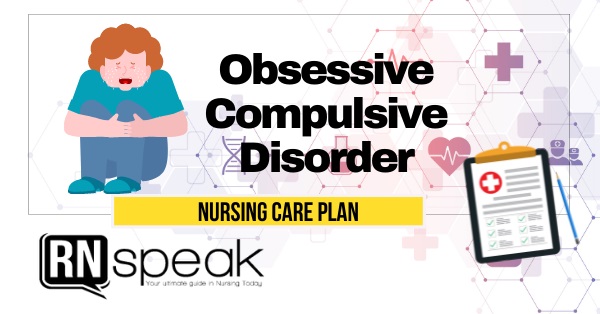Obsessive Compulsive Disorder is a neurological disorder in which obsessions and compulsions are present. OCD is an anxiety disorder marked by persistent, unwanted thoughts that intrude upon the mind and by compulsive behaviors and unneeded actions by a person feels must be done repeatedly in certain rigid and consistent ways.
Patients suffer from such disorders are an aware that they have a psychological problem that leads them to think and behave like irrational in particular circumstances. They usually have fears and anxieties that they cannot seem to control. It’s as if their brains get stuck on a certain thought and keep on repeatedly. To relieve their anxiety and nervousness, they commit these repetitive behaviors.
Nursing Priorities
- Assist client to recognize the onset of anxiety.
- Explore the meaning and purpose of the behavior with the client.
- Assist client to limit ritualistic behaviors.
- Help clients learn alternative responses to stress.
- Encourage family participation in the therapy programs.
Discharge Goals
- Anxiety decreased to a manageable level.
- Ritualistic behaviors managed/minimized.
- Environmental and interpersonal stress decreased.
- Client/family involved in support group/community programs.
- Plan in place to meet needs after discharge.
Nursing Diagnosis: Severe Anxiety
May Be Related to
- Earlier life conflicts(may be reflected in the nature of the repetitive actions and recurring thoughts)
Evidenced by
- Repetitive action (e.g., hand-washing)
- Recurring thoughts (e.g., dirt and germs)
- Decreased social and role functioning
Desired Outcomes
- Verbalize understanding of significance of ritualistic behaviors and relationship to anxiety.
- Demonstrate ability to cope effectively with stressful situations without resorting to obsessive thoughts or compulsive behaviors.
Obsessive Compulsive Disorder Nursing Care Plan – Severe Anxiety PDF
Obsessive Compulsive Disorder Nursing Care Plan [Full Text]
| Nursing Action | Rationale |
|---|---|
| Establish relationship through use of empathy, warmth, and respect. Demonstrate interest in client as a person through use of attending behaviors. | Anything about which the client feels anxious will serve to increase the ritualistic behaviors. Establishing trust provides support and communicates that the nurse accepts the client as a person with the right to self-determination. |
| Acknowledge behavior without focusing attention on it. Verbalize empathy toward client’s experience rather than disapproval or criticism. Better to say,” I see you undress 3 times every morning. That must be tiring for you,” rather than “Try to dress only 1 time today.” | Lack of attention to ritualistic behaviors can diminish them. As anxiety is reduced, the need for behaviors is reduced. Reflecting the client’s feelings may reduce the intensity of the ritualistic behavior |
| Use a relaxed manner with the client; keep the environment calm. | Any attempts to decrease stress will help the client to feel less anxious, which may reduce the intensity of the ritualistic behaviors. |
| Assist client to learn stress management, (e.g., thought-stopping, relaxation exercises, imagery). | Stress-management techniques can be used, instead of ritualistic behaviors, to break habitual pattern. |
| Identify what the client perceives as relaxing (e.g., warm bath, music). Engage in constructive activities such as quiet games that require concentration, as well as arts and crafts such as needlework, woodworking, ceramics, and painting. | Planned activities allow the client less time forward bath, music). Engage in constructive activities such as quiet games that require concentration, as well as arts and crafts such as needle work, woodworking, ceramics, and painting. |
| Encourage participation in a regular exercise program. | Exercise therapy can help relieve anxiety. Note: Exercise does not need to be aerobic or intensive to achieve the desired effect. |
| Give positive reinforcement for non-compulsive behavior. Avoid reinforcing compulsive behavior. Help significant other(s) learn the value of not focusing on the ritualistic behaviors. | This approach will prevent the client from obtaining secondary gains from the maladaptive behaviors. |
| Assist client to find ways to set limits on own behaviors. At the same time allow adequate time during the daily routine for the ritual(s). | Encourages client to problem-solve ways to limit own behaviors while recognizing that behaviors cannot be stopped by others without increasing anxiety. If the time required for performing the ritual(s) is not considered in planning care, client will feel rushed and anxious while performing behaviors. A mistake in compulsive behavior is more likely to be made if client feels rushed, and the whole ritual will have to be started again, resulting in increased anxiety — possibly to an unmanageable level. |
| Limit the amount of time allotted for the performance of rituals. Encourage client to gradually decrease this time. | Provides initial control of maladaptive behaviors until client can enforce own limits and substitute more adaptive response(s) to stress. |
| Encourage client to explore the meaning and purpose of behaviors; to describe the feelings when the behaviors occur, intensify, or are interrelated ;and to examine the precipitating factors to the performance of the rituals | This exploration provides an opportunity to begin to understand the process and gain control over the obsessive-compulsive sequence. When the opportunity for ritualistic behavior does not occur, the client fears that something bad will happen. Recognizing precipitating factors allows client to interrupt escalating anxiety. |
| Discuss home situation, include family/SO as appropriate. Involve in discharge plan. | Returning to unchanged home environment Increases risk that client will resume compulsive behaviors. |
| Administer medications as indicated,e.g.:Fluvoxamine(Luvox),clomipramine(Anafranil),fluoxetine (Prozac) | These drugs help balance serotonin levels, decreasing feelings of anxiety, reducing need for ritualistic behavior(s), and allowing client to learn of other methods of stress reduction. Note: Luvox is classified as a selective serotonin reuptake inhibitor and has fewer side effects than tricyclics. |
| Administer Buspirone (BuSpar) and lithium (Eskalith) ,Sertraline (Zoloft), venlafaxine (Effexor)medications as indicated. | Clients who are refractory to antidepressants may require combination therapy (e.g., buspirone and fluoxetine or lithium and clomipramine). |








